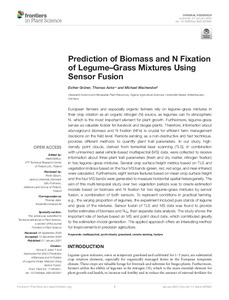| dc.date.accessioned | 2021-03-12T12:15:48Z | |
| dc.date.available | 2021-03-12T12:15:48Z | |
| dc.date.issued | 2021-01-21 | |
| dc.identifier | doi:10.17170/kobra-202103123502 | |
| dc.identifier.uri | http://hdl.handle.net/123456789/12628 | |
| dc.description.sponsorship | Gefördert durch den Publikationsfonds der Universität Kassel | |
| dc.language.iso | eng | |
| dc.rights | Namensnennung 4.0 International | * |
| dc.rights.uri | http://creativecommons.org/licenses/by/4.0/ | * |
| dc.subject | multispectral | eng |
| dc.subject | point clouds | eng |
| dc.subject | grasslands | eng |
| dc.subject | remote sensing | eng |
| dc.subject | texture | eng |
| dc.subject.ddc | 630 | |
| dc.title | Prediction of biomass and N fixation of legume-grass mixtures using sensor fusion | eng |
| dc.type | Aufsatz | ger |
| dcterms.abstract | European farmers and especially organic farmers rely on legume–grass mixtures in their crop rotation as an organic nitrogen (N) source, as legumes can fix atmospheric N, which is the most important element for plant growth. Furthermore, legume–grass serves as valuable fodder for livestock and biogas plants. Therefore, information about aboveground biomass and N fixation (NFix) is crucial for efficient farm management decisions on the field level. Remote sensing, as a non-destructive and fast technique, provides different methods to quantify plant trait parameters. In our study, highdensity point clouds, derived from terrestrial laser scanning (TLS), in combination with unmanned aerial vehicle-based multispectral (MS) data, were collected to receive information about three plant trait parameters (fresh and dry matter, nitrogen fixation) in two legume–grass mixtures. Several crop surface height metrics based on TLS and vegetation indices based on the four MS bands (green, red, red edge, and near-infrared) were calculated. Furthermore, eight texture features based on mean crop surface height and the four MS bands were generated to measure horizontal spatial heterogeneity. The aim of this multi-temporal study over two vegetation periods was to create estimation models based on biomass and N fixation for two legume–grass mixtures by sensor fusion, a combination of both sensors. To represent conditions in practical farming, e.g., the varying proportion of legumes, the experiment included pure stands of legume and grass of the mixtures. Sensor fusion of TLS and MS data was found to provide better estimates of biomass and NFix than separate data analysis. The study shows the important role of texture based on MS and point cloud data, which contributed greatly to the estimation model generation. The applied approach offers an interesting method for improvements in precision agriculture. | eng |
| dcterms.accessRights | open access | |
| dcterms.creator | Grüner, Esther | |
| dcterms.creator | Astor, Thomas | |
| dcterms.creator | Wachendorf, Michael | |
| dcterms.extent | 13 Seiten | |
| dc.relation.doi | doi:10.3389/fpls.2020.603921 | |
| dc.subject.swd | Fernerkundung | ger |
| dc.subject.swd | Punktwolke | ger |
| dc.subject.swd | Biomasse | ger |
| dc.subject.swd | Grünland | ger |
| dc.subject.swd | Wiese | ger |
| dc.subject.swd | Textur | ger |
| dc.type.version | publishedVersion | |
| dcterms.source.identifier | EISSN 1664-462X | |
| dcterms.source.journal | Frontiers in plant science | eng |
| dcterms.source.volume | Volume 11 | |
| kup.iskup | false | |
| dcterms.source.articlenumber | Article 603921 | |


